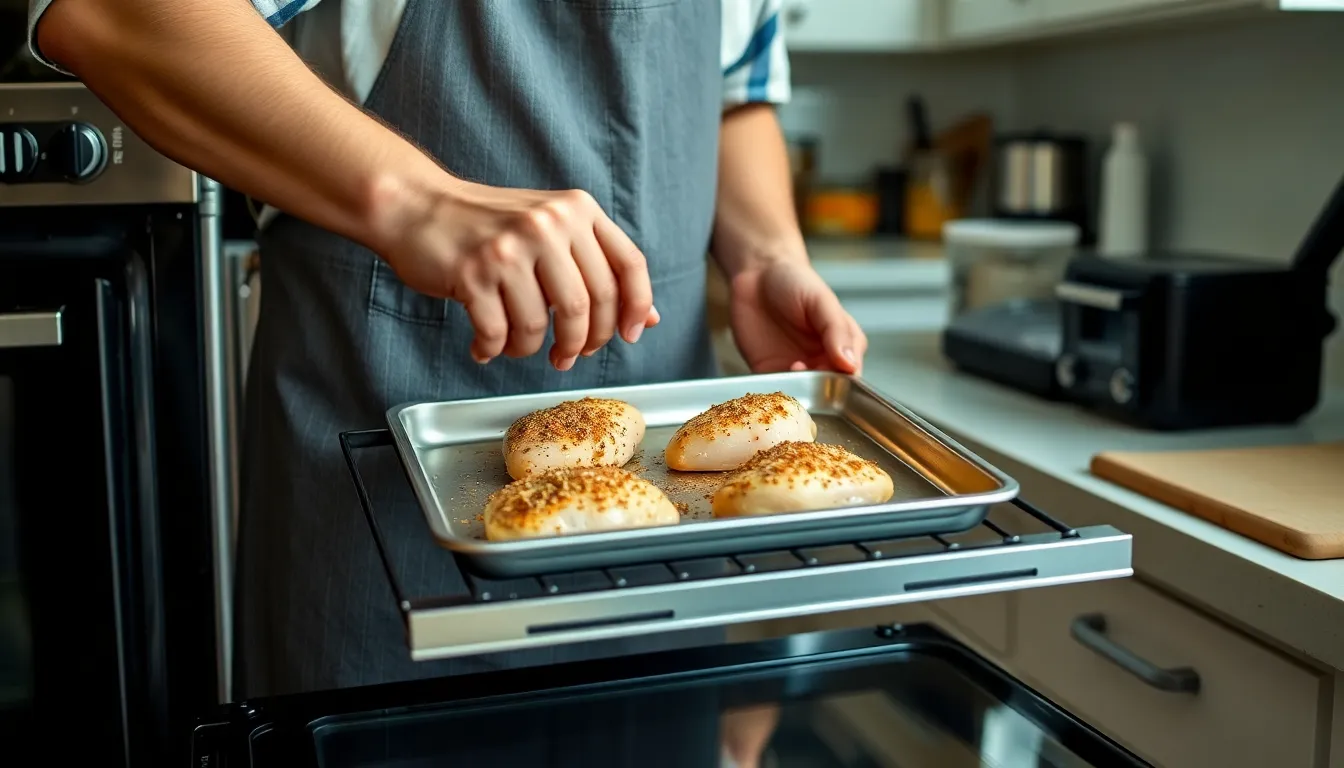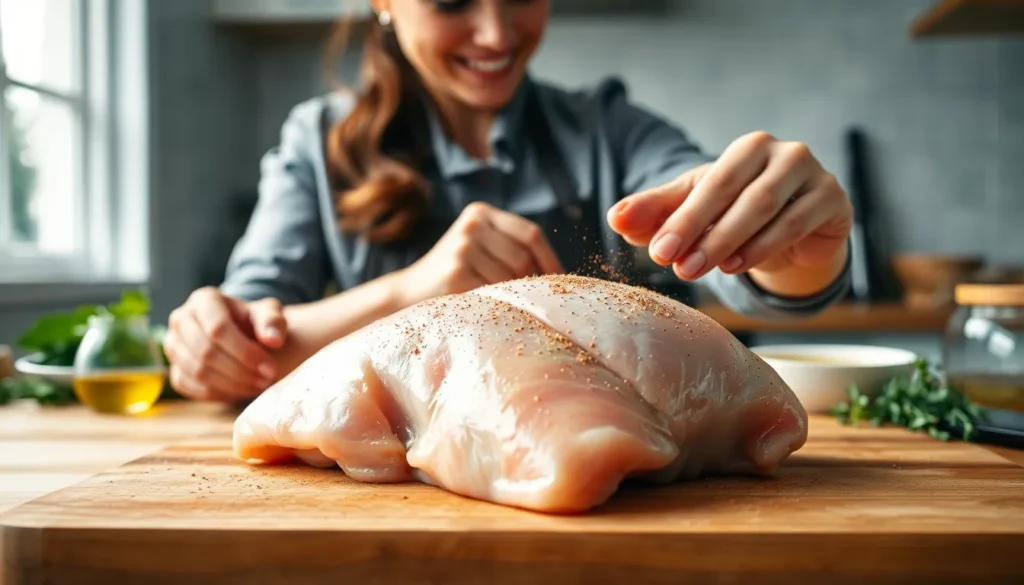Imagine this: it’s a hectic weeknight, and dinner’s looming like a dark cloud. You open the freezer, and there it is—frozen chicken breast, staring back at you like a deer in headlights. Panic sets in, but fear not! Cooking chicken breast from frozen isn’t just a culinary pipe dream; it’s a game-changer.
Not only can you whip up a delicious meal without defrosting, but you can also impress your friends with your kitchen wizardry. With a few simple techniques, that icy block can transform into a juicy, flavorful dish. So, roll up those sleeves and get ready to turn frozen poultry into a dinner that’ll have everyone singing your praises. Who knew that a frozen chicken could be the hero of your dinner saga?
Table of Contents
ToggleOverview of Cooking Chicken Breast from Frozen
Cooking chicken breast from frozen provides an effective solution for quick meals. Home cooks can prepare delicious, juicy dishes without the lengthy thawing process. Using methods like baking, grilling, or poaching guarantees tender results without any additional preparation time.
Safety measures should remain a priority while handling frozen poultry. Cooking chicken from a frozen state necessitates appropriate timing. For oven baking, a temperature of 350°F typically suffices. It generally takes 50% longer to cook frozen chicken compared to thawed chicken, usually ranging from 30 to 45 minutes.
Using a meat thermometer, confirm that the internal temperature reaches 165°F. This confirms that potential bacteria have been eliminated. Cooking methods like slow cooking or pressure cooking may produce varying textures, but they yield equally safe results.
Seasoning frozen chicken breast effectively begins right before or during cooking. Applying spice blends or marinades can enhance flavors, making the finished meal more appealing. Experimenting with different seasonings could lead to distinctive taste profiles.
It’s essential to check for doneness properly. Uneven cooking can occur in larger pieces, so it may help to slice the chicken for even heat distribution. Uninterrupted cooking times ensure that frozen chicken transforms into a culinary delight, eliminating concerns about safety or palatability.
Utilizing frozen chicken breast encourages creativity in meal preparation. Various cooking methods suit frozen chicken, including stir-frying and sautéing. Satisfy cravings for diverse cuisines by incorporating frozen chicken into recipes that span global flavors.
Cooking chicken breast from frozen serves as a practical approach for busy individuals. A variety of delicious and safe methods encourages culinary experimentation and innovation.
Methods for Cooking Frozen Chicken Breast

Cooking frozen chicken breast can be quick and simple, with several effective methods. Here are some popular techniques to consider.
Oven Baking
Oven baking offers an easy way to prepare frozen chicken breast. Preheat the oven to 350°F to ensure even cooking. Place the frozen chicken breasts on a baking sheet lined with parchment paper. Season the chicken with herbs or spices to enhance flavor. Bake the chicken for approximately 30 to 45 minutes, depending on the thickness of the breasts. Verify the internal temperature reaches 165°F for safe consumption. Allow the chicken to rest for a few minutes before slicing to maintain juiciness.
Instant Pot
Using an Instant Pot provides a fast cooking option for frozen chicken breast. Add one cup of water or broth to the pot to create steam. Place the frozen chicken breast on a rack inside, ensuring it doesn’t touch the liquid. Set the Instant Pot to high pressure for 12 to 15 minutes, depending on size. After cooking, perform a quick release of pressure. Check that the internal temperature is at least 165°F before serving. This method yields tender chicken, perfect for various recipes.
Sous Vide
Sous vide allows for precise cooking of frozen chicken breast without the risk of drying out. Fill a large container with water and preheat the sous vide machine to 140°F to 160°F, based on your preferred doneness. Seal the frozen chicken breasts in a vacuum bag, ensuring air is removed. Submerge the bag in the water bath for 1.5 to 4 hours. The vacuum-sealed environment cooks the chicken while retaining moisture and flavor. Sear the cooked chicken in a hot skillet for a few minutes to add a nice crust before serving.
Safety Considerations
Cooking frozen chicken breast requires attention to safety. Ensuring proper cooking practices minimizes health risks.
Proper Cooking Temperatures
Cook chicken breast to an internal temperature of 165°F. Using a food thermometer provides an accurate reading. Although cooking times vary, frozen chicken typically takes 50% longer than thawed varieties. For instance, roasting at 350°F takes about 30 to 45 minutes. Checking multiple spots ensures even cooking throughout the meat. Always let the chicken rest for a few minutes post-cooking to enhance juiciness.
Avoiding Foodborne Illness
Preventing foodborne illness is crucial when handling poultry. Keeping raw chicken separate from other foods limits cross-contamination risks. Wash hands, utensils, and surfaces with hot, soapy water after contact with raw chicken. Thawing chicken in the refrigerator rather than at room temperature is safer. Using a microwave or cold water can expedite thawing if cooking immediately. Following these guidelines significantly reduces the chances of contracting foodborne illnesses.
Benefits and Drawbacks
Cooking chicken breast from frozen presents several benefits and drawbacks worth considering. Understanding these aspects enhances decision-making in meal preparation.
Advantages of Cooking from Frozen
Convenience ranks high among the advantages. It eliminates the need for defrosting, making it easy to whip up a meal in a hurry. Time-saving efforts lead to quick cooking sessions, with methods like baking or using an Instant Pot requiring minimal prep. Flavor can still shine through, as seasoning added during cooking enhances the taste. Moisture retention typically occurs, especially when methods such as sous vide are applied. Additionally, safety concerns lessen due to controlled cooking methods that ensure temperatures reach 165°F.
Disadvantages to Consider
Cooking from frozen often results in longer preparation times, with cooking taking about 50% longer than thawed chicken. Uneven cooking may happen if not monitored closely, leading to some areas remaining undercooked. Texture might differ, as frozen meat can sometimes become drier than freshly thawed. Limited seasoning options exist initially since flavors can’t penetrate the surface until it begins to cook. The need for precise temperature checks arises to ensure food safety and avoid any health risks.
Cooking chicken breast from frozen isn’t just a convenient option; it’s a smart solution for busy weeknights. With the right techniques and a focus on safety, anyone can create a delicious meal without the hassle of thawing.
Whether using the oven, Instant Pot, or sous vide method, the possibilities are endless. By embracing this approach, home cooks can enjoy flavorful and juicy chicken while saving time in the kitchen.
So next time dinner sneaks up, remember that frozen chicken can be a hero on the dinner table, ready to impress with minimal effort.




